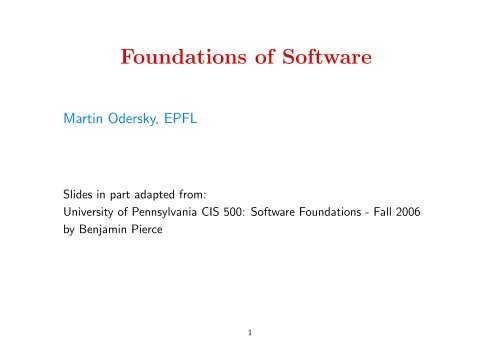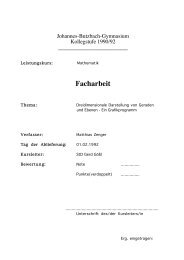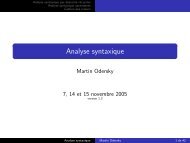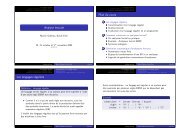Foundations of Software - LAMP - EPFL
Foundations of Software - LAMP - EPFL
Foundations of Software - LAMP - EPFL
Create successful ePaper yourself
Turn your PDF publications into a flip-book with our unique Google optimized e-Paper software.
<strong>Foundations</strong> <strong>of</strong> S<strong>of</strong>tware<br />
Martin Odersky, <strong>EPFL</strong><br />
Slides in part adapted from:<br />
University <strong>of</strong> Pennsylvania CIS 500: S<strong>of</strong>tware <strong>Foundations</strong> - Fall 2006<br />
by Benjamin Pierce<br />
1
Course Overview<br />
2
What is “s<strong>of</strong>tware foundations”?<br />
S<strong>of</strong>tware foundations (or ”theory <strong>of</strong> programming languages”) is the<br />
mathematical study <strong>of</strong> the meaning <strong>of</strong> programs.<br />
The goal is finding ways to describe program behaviors that are both<br />
precise and abstract.<br />
� precise so that we can use mathematical tools to formalize and<br />
check interesting properties<br />
� abstract so that properties <strong>of</strong> interest can be discussed clearly,<br />
without getting bogged down in low-level details<br />
3
Why study s<strong>of</strong>tware foundations?<br />
� To prove specific properties <strong>of</strong> particular programs (i.e., program<br />
verification)<br />
⊲ Important in some domains (safety-critical systems, hardware<br />
design, security protocols, inner loops <strong>of</strong> key algorithms, ...),<br />
but still quite difficult and expensive<br />
� To develop intuitions for informal reasoning about programs<br />
� To prove general facts about all the programs in a given<br />
programming language (e.g., safety or isolation properties)<br />
� To understand language features (and their interactions) deeply and<br />
develop principles for better language design<br />
(PL is the ”materials science” <strong>of</strong> computer science...)<br />
4
What you can expect to get out <strong>of</strong> the course<br />
� A more sophisticated perspective on programs, programming<br />
languages, and the activity <strong>of</strong> programming<br />
⊲ See programs and whole languages as formal, mathematical<br />
objects<br />
⊲ Make and prove rigorous claims about them<br />
⊲ Detailed knowledge <strong>of</strong> a variety <strong>of</strong> core language features<br />
� Deep intuitions about key language properties such as type safety<br />
� Powerful tools for language design, description, and analysis<br />
Most s<strong>of</strong>tware designers are language designers!<br />
5
Greenspun’s Tenth Rule Of Programming<br />
Any sufficiently complicated C or Fortran program contains an<br />
ad-hoc, informally-specified, bug-ridden, slow implementation <strong>of</strong><br />
half <strong>of</strong> CommonLisp.<br />
– Philip Greenspun<br />
6
What this course is not<br />
� An introduction to programming<br />
� A course on functional programming (though we’ll be doing some<br />
functional programming along the way)<br />
� A course on compilers (you should already have basic concepts such<br />
as lexical analysis, parsing, abstract syntax, and scope under your<br />
belt)<br />
� A comparative survey <strong>of</strong> many different programming languages and<br />
styles<br />
7
Approaches to Program Meaning<br />
� Denotational semantics and domain theory view programs as simple<br />
mathematical objects, abstracting away their flow <strong>of</strong> control and<br />
concentrating on their input-output behavior.<br />
� Program logics such as Hoare logic and dependent type theories<br />
focus on logical rules for reasoning about programs.<br />
� Operational semantics describes program behaviors by means <strong>of</strong><br />
abstract machines. This approach is somewhat lower-level than the<br />
others, but is extremely flexible.<br />
� Process calculi focus on the communication and synchronization<br />
behaviors <strong>of</strong> complex concurrent systems.<br />
� Type systems describe approximations <strong>of</strong> program behaviors,<br />
concentrating on the shapes <strong>of</strong> the values passed between different<br />
parts <strong>of</strong> the program.<br />
8
Overview<br />
This course will concentrate on operational techniques and type systems.<br />
� Part I: Modeling programming languages<br />
⊲ Syntax and parsing<br />
⊲ Operational semantics<br />
⊲ Inductive pro<strong>of</strong> techniques<br />
⊲ The lambda-calculus<br />
⊲ Syntactic sugar; fully abstract translations<br />
� Part II: Type systems<br />
⊲ Simple types<br />
⊲ Type safety<br />
⊲ References<br />
⊲ Subtyping<br />
9
Overview<br />
� Part III: Object-oriented features (case study)<br />
⊲ A simple imperative object model<br />
⊲ An analysis <strong>of</strong> core Java<br />
⊲ An analysis <strong>of</strong> core Scala<br />
10
Organization <strong>of</strong> the Course<br />
11
People<br />
Instructor: Adriaan Moors (filling in for pr<strong>of</strong>. Martin Odersky)<br />
INR 316<br />
<br />
Teaching Assistant: Ingo Maier<br />
INR 320<br />
Contact him about pairing up for the exercises!<br />
<br />
12
Information<br />
Textbook: Types and Programming Languages,<br />
Benjamin C. Pierce, MIT Press, 2002<br />
Webpage: http://lampwww.epfl.ch/teaching/foundations <strong>of</strong> s<strong>of</strong>tware/<br />
13
Elements <strong>of</strong> the Course<br />
� The <strong>Foundations</strong> <strong>of</strong> S<strong>of</strong>tware course consists <strong>of</strong><br />
⊲ lecture (Tuesday 10:15-12:00, room INM 10)<br />
⊲ exercises and project work (Thursday 8:15-10:00, room INF 1)<br />
� The lecture will follow in large parts the textbook.<br />
� For lack <strong>of</strong> time, we cannot treat all essential parts <strong>of</strong> the book in<br />
the lectures, that’s why the textbook is required reading for<br />
participants <strong>of</strong> the course.<br />
14
Homework and Projects<br />
You will be asked to<br />
� solve and hand in some written exercise sheets,<br />
� do a number <strong>of</strong> programming assignments, including<br />
⊲ parsers,<br />
⊲ interpreters and reduction engines,<br />
⊲ type checkers<br />
for a variety <strong>of</strong> small languages.<br />
� The recommended implementation language for these assignments is<br />
Scala.<br />
15
Scala<br />
� Scala is a functional and object-oriented language that is closely<br />
interoperable with Java.<br />
� It is very well suited as an implementation language for<br />
type-checkers, in particular because it supports:<br />
⊲ pattern matching,<br />
⊲ higher-order functions,<br />
⊲ inheritance and mixins.<br />
16
Learning Scala<br />
If you don’t know Scala yet, there’s help:<br />
� The Scala web site:<br />
www.scala-lang.org<br />
� On this site, the documents:<br />
⊲ A Brief Scala Tutorial - an introduction to Scala for Java<br />
programmers. (short and basic).<br />
⊲ An Introduction to Scala (longer and more comprehensive).<br />
⊲ An Overview <strong>of</strong> the Scala Programming Language (high-level).<br />
⊲ Scala By Example (long, comprehensive, tutorial style).<br />
� The assistants.<br />
17
Grading and Exams<br />
Final course grades will be computed as follows:<br />
� Homework and project: 30%<br />
� Mid-term exam: 30%<br />
� Final exam: 40%<br />
Exams:<br />
1. Mid-term: mid November 2010 (exact date TBA)<br />
2. Final exam: to be announced<br />
(dates are provisional)<br />
18
Collaboration<br />
� Collaboration on homework is strongly encouraged.<br />
� Studying with other people is the best way to internalize the material<br />
� Form pair programming and study groups!<br />
2-3 people is a good size. 4 is too many for all to have equal input.<br />
”You never really misunderstand something<br />
until you try to teach it...<br />
” – Anon.<br />
19
Plagiarism<br />
� A single group will <strong>of</strong> course share code.<br />
� But plagiarizing code by other groups as part <strong>of</strong> a project is<br />
unethical and will not be tolerated, whatever the source.<br />
20
Part I<br />
Modelling programming languages<br />
21
Syntax and Parsing<br />
� The first-level <strong>of</strong> modeling a programming language concerns its<br />
context-free syntax.<br />
� Context free syntax determines a set <strong>of</strong> legal phrases and determines<br />
the (tree-)structure <strong>of</strong> each <strong>of</strong> them.<br />
� It is <strong>of</strong>ten given on two levels:<br />
⊲ concrete: determines the exact (character-by-character) set <strong>of</strong><br />
legal phrases<br />
⊲ abstract: concentrates on the tree-structure <strong>of</strong> legal phrases.<br />
� We will be mostly concerned with abstract syntax in this course.<br />
� But to be able to write complete programming tools, we need a<br />
convenient way to map character sequences to trees.<br />
22
Approaches to Parsing<br />
There are two ways to construct a parser:<br />
� By hand Derive a parser program from a grammar.<br />
� Automatic Submit a grammar to a tool which generates the parser<br />
program.<br />
In the second approach, one uses a special grammar description language<br />
to describe the input grammar.<br />
23
Domain-Specific Languages<br />
� The grammar description language is an example <strong>of</strong> a<br />
domain-specific language (DSL).<br />
� The parser generator acts as a processor (“compiler”) for this<br />
language — that’s why it’s sometimes called grandly a<br />
“compiler-compiler”.<br />
� Example <strong>of</strong> a “program” in the grammar description DSL:<br />
Expr ::= Term {’+’ Term | ’−’ Term}.<br />
Term ::= Factor {’∗’ Factor | ’/’ Factor}.<br />
Factor ::= Number | ’(’ Expr ’)’.<br />
24
Embedded Domain Specific Languages<br />
� An alternative to a stand-alone DSL is an Embedded DSL.<br />
� Here, the DSL does not exist as a separate language but as an API<br />
in a host language.<br />
� The host language is usually a general purpose programming<br />
language.<br />
We will now develop this approach for grammar description languages.<br />
25
An EDSL for Parsing in Scala<br />
We will develop a framework so that parsers can be described like this:<br />
def expr : Parser[Any] = term ˜ rep(”+” ˜ term | ”−” ˜ term)<br />
def term : Parser[Any] = factor ˜ rep(”∗” ˜ factor | ”/” ˜ factor)<br />
def factor : Parser[Any] = ”(” ˜ expr ˜ ”)” | numericLit<br />
A small Perl hack could derive the above code from the informal<br />
grammar definition above:<br />
� Insert a def at the beginning <strong>of</strong> each production.<br />
� The “::=” becomes “: Parser[Any] =”.<br />
� Sequential composition is now expressed by a ˜.<br />
� Repetition {...} is now expressed by rep(...).<br />
26
� Option [...] is now expressed by opt(...).<br />
27
Parser Combinators<br />
� The differences between Grammar A and Grammar B are fairly<br />
minor.<br />
(Note in particular that existing DSLs for grammar<br />
descriptions also tend to add syntactic complications to the<br />
idealized Grammar A we have seen).<br />
� The important difference is that Grammar B is a valid Scala<br />
program, when combined with an API that defines the necessary<br />
primitives.<br />
� These primitives are called parser combinators.<br />
28
The Basic Idea<br />
For each language (identified by grammar symbol S), define a<br />
function fS that, given an input stream i,<br />
� if a prefix <strong>of</strong> i is in S, return Success(Pair(x, i ′ )) where x is<br />
a result for S and i ′ is the rest <strong>of</strong> the input.<br />
� otherwise, return Failure(msg, i) where msg is an error<br />
message string.<br />
The first behavior is called success, the second failure.<br />
29
The Basic Idea in Code<br />
Assume:<br />
class StandardTokenParsers {<br />
type Parser = Input ⇒ ParseResult<br />
where<br />
type Input = Reader[Token] // a stream <strong>of</strong> Tokens with positions.<br />
and we assume a class Token with subclasses<br />
⊲ case class Keyword(chars : String) for keywords,<br />
⊲ case class NumericLit(chars : String) for numbers,<br />
⊲ case class StringLit(chars : String) for strings,<br />
⊲ case class Identifier(chars : String) for identifiers.<br />
30
In each case, chars represents the characters making up the token.<br />
31
Also assume a class ParseResult[T] with subclasses<br />
case class Success[T](result : T, in : Input)<br />
extends ParseResult[T]<br />
case class Failure(msg : String, in : Input)<br />
extends ParseResult[Nothing]<br />
32
Object-Oriented Parser Combinators<br />
� In fact, we will also need to express | and ˜ as methods <strong>of</strong> parsers.<br />
� That’s why we extend the function type <strong>of</strong> parsers as follows:<br />
abstract class Parser[T] extends (Input ⇒ ParseResult[T]) {<br />
// An unspecified method that defines the parser function.<br />
def apply(in : Input): ParseResult<br />
}<br />
// A parser combinator for sequential composition<br />
def ˜ ...<br />
// A parser combinator for alternative composition<br />
def | ...<br />
It remains to define concrete combinators that implement this class (see<br />
below).<br />
33
A Generic Single-Token Parser<br />
� The following parser succeeds if the first token in the input satisfies<br />
a given predicate p.<br />
� If it succeeds, it reads the token string and returns it as a result.<br />
def token(kind : String)(p : Token ⇒ boolean) = new Parser[String] {<br />
def apply(in : Input) =<br />
if (p(in.head)) Success(in.head.chars, in.tail)<br />
else Failure(kind+” expected”, in)<br />
}<br />
34
Specific Single-Token Parsers<br />
� The following parser succeeds if the first token in the input is the<br />
given keyword chars:<br />
� If it succeeds, it returns a keyword token as a result.<br />
implicit def keyword(chars : String) = token(”’”+chars+”’”) {<br />
case Keyword(chars1) ⇒ chars == chars1<br />
case ⇒ false<br />
}<br />
� Note that keyword is marked implicit, so that you can usually write ”if”<br />
instead <strong>of</strong> keyword(”if”).<br />
35
� The following parsers succeed if, respectively, the first token in the<br />
input is a numeric or string literal, or an identifier.<br />
def numericLit = token(”number”)( .isInstanceOf[NumericLit])<br />
def stringLit = token(”string literal”)( .isInstanceOf[StringLit])<br />
def ident = token(”identifier”)( .isInstanceOf[Identifier])<br />
36
The Sequence Combinator<br />
� The sequence combinator P ˜ Q succeeds if P and Q succeed<br />
sequentially, and returns the concatenation <strong>of</strong> their results.<br />
� ˜ is implemented as a method <strong>of</strong> class Parser.<br />
abstract class Parser[T] {<br />
def ˜ [U](q : Parser[U]) = new Parser[T ˜ U] {<br />
def apply(in : Input) = Parser.this(in) match {<br />
case Success(x, in1) ⇒<br />
q(in1) match {<br />
case Success(y, in2) ⇒ Success(new ˜(x, y), in2)<br />
case failure ⇒ failure<br />
}<br />
case failure ⇒ failure<br />
}<br />
}<br />
37
Concatenating Results<br />
Normally, the ˜ combinator returns a the results <strong>of</strong> the two parsers that<br />
are run sequentially wrapped in a ˜-object.<br />
The case class ˜ is similar to Pair (but ˜ turns out to be nicer – see<br />
below).<br />
case class ˜[T, U]( 1 : T, 2 : U) {<br />
override def toString = ”(”+ 1 +” ˜ ”+ 2 +”)”<br />
}<br />
There are also two variants <strong>of</strong> ˜ which return only the left or only the right<br />
operand:<br />
P Q // returns only Q’s result<br />
38
The Alternative Combinator<br />
� The alternative combinator P | Q succeeds if either P or Q<br />
succeeds.<br />
� It returns the result <strong>of</strong> P if P succeeds, or the result <strong>of</strong> Q, if Q<br />
succeeds.<br />
� The alternative combinator is implemented as a method <strong>of</strong> class<br />
Parser.<br />
def | (q : ⇒ Parser[T]) = new Parser[T] {<br />
def apply(in : Input) = Parser.this(in) match {<br />
case s1 @ Success( , ) ⇒ s1<br />
case failure ⇒ q(in)<br />
}<br />
}<br />
39
Failure And Success Parsers<br />
� The parser failure(msg) always fails with the given error message. It<br />
is implemented as follows:<br />
def failure(msg : String) = new Parser[Nothing] {<br />
def apply(in : Input) = Failure(msg, in)<br />
}<br />
� The parser success(result) always succeeds with the given result. It does<br />
not consume any input. It is implemented as follows:<br />
def success[T](result : T) = new Parser[T] {<br />
def apply(in : Input) = Success(result, in)<br />
}<br />
40
Result Conversion<br />
The parser P ˆˆ f succeeds iff P succeeds. In that case it returns the<br />
result <strong>of</strong> applying f to the result <strong>of</strong> P .<br />
def ˆˆ [U](f : T ⇒ U) = new Parser[U] {<br />
def apply(in : Input) = Parser.this(in) match {<br />
case Success(x, in1) ⇒ Success(f(x), in1)<br />
case f ⇒ f<br />
}<br />
}<br />
A variant ˆˆˆ takes a value V as right hand side argument.<br />
It returns V if the left hand parser succeeds:<br />
def ˆˆˆ [U](r : U): Parser[U] = ˆˆ (x ⇒ r)<br />
41
Option and Repetition Combinators<br />
� The opt(P ) combinator always succeeds and returns an Option<br />
result.<br />
It returns Some(R) iff P succeeds with R. In case <strong>of</strong> failure, the<br />
result is None.<br />
� The rep(P ) combinator applies P zero or more times until it fails,<br />
the result is a list <strong>of</strong> P ’s results.<br />
The two combinators are implemented as follows:<br />
def opt[T](p : Parser[T]): Parser[Option[T]] =<br />
p ˆˆ Some | success(None)<br />
def rep[T](p : Parser[T]): Parser[List[T]] =<br />
p ˜ rep(p) ˆˆ { case x ˜ xs ⇒ x :: xs } | success(List())<br />
Note that neither <strong>of</strong> these combinators can fail!<br />
42
The Interleaved Repetition Combinator<br />
The repsep(P , Q) parser parses a (possibly empty) sequence<br />
P Q P ... Q P<br />
It returns a list <strong>of</strong> all results returned by P .<br />
Example: repsep(ident, ”,”) parses a list <strong>of</strong> identifiers separated by<br />
commas.<br />
The repsep combinator is implemented as follows:<br />
def repsep[T, U](p : Parser[T], q : Parser[U]): Parser[List[T]] =<br />
p ˜ rep(q ˜> p) ˆˆ { case r ˜ rs ⇒ r :: rs } | success(List())<br />
43
Other Combinators<br />
More combinators can be defined if necessary.<br />
Exercise: Implement the rep1(P ) parser combinator, which applies P<br />
one or more times.<br />
Exercise: Define opt and rep directly, without making use <strong>of</strong> ˜, |, and<br />
empty.<br />
44
An Example: JSON<br />
JSON, or JavaScript Object Notation, is a popular data interchange<br />
format.<br />
JSON data essentially consists <strong>of</strong> objects {...}, arrays [...], numbers, and<br />
strings.<br />
Here is an example <strong>of</strong> a JSON value:<br />
{ ”address book”: {<br />
”name”: ”John Smith”,<br />
”address”: { ”street”: ”10 Market Street”,<br />
”city” : ”San Francisco, CA”,<br />
”zip” : 94111 },<br />
”phone numbers”: [”408 338−4238”, ”408 111−6892”]<br />
}<br />
}<br />
45
A JSON parser<br />
package examples.parsing<br />
// import the standard parser class<br />
import scala.util.parsing.combinator.syntactical.StandardTokenParsers<br />
object JSON extends StandardTokenParsers {<br />
// fix some delimiter symbols ...<br />
lexical.delimiters += (”{”, ”}”, ”[”, ”]”, ”:”)<br />
// ... and some reserved words<br />
lexical.reserved += (”null”, ”true”, ”false”)<br />
// here are the four productions making up the JSON grammar<br />
def obj : Parser[Any] = ”{” ˜ repsep(member, ”,”) ˜ ”}”<br />
def arr : Parser[Any] = ”[” ˜ repsep(value, ”,”) ˜ ”]”<br />
def member : Parser[Any] = stringLit ˜ ”:” ˜ value<br />
def value : Parser[Any] = stringLit | numericLit | obj | arr |<br />
”null” | ”true” | ”false”<br />
46
Testing the JSON Parser<br />
Add a method main that can be used to test the parser.<br />
def main(args : Array[String]) {<br />
val tokens = new lexical.Scanner(args(0))<br />
println(args(0))<br />
println(phrase(value)(tokens))<br />
}<br />
Here are two test runs:<br />
>java examples.parsing.JSON ”{ ”x”: true, ”y”: [1, 2, 3] }”<br />
{ x : true, y : [1, 2, 3] }<br />
[1.26] parsed : (({ ˜ List(((x ˜ :) ˜ true), ((y ˜ :) ˜ (([ ˜ List(1,<br />
2, 3)) ˜ ])))) ˜ })<br />
47
java examples.parsing.JSON ”{ ”x”: true ”y”: [1, 2] }”<br />
{ x : true y : [1, 2] }<br />
[1.13] failure : unexpected token string literal y<br />
{ ”x”: true ”y”: [1, 2] }<br />
ˆ<br />
48
Getting Better Output<br />
� The result <strong>of</strong> the previous JSON parser was a tree containing all<br />
input tokens (slightly chaotically).<br />
� We transform the productions using the ˆˆ combinator to get more<br />
structured output:<br />
def obj : Parser[Any] = // return a Map<br />
”{” ˜> rep(member) rep{value}
def value : Parser[Any] = (<br />
obj<br />
| arr<br />
| stringLit<br />
| numericLit ˆˆ ( .toInt) // return an Int<br />
| ”null” ˆˆˆ null // return ‘null’<br />
| ”true” ˆˆˆ true // return ‘true’<br />
| ”false” ˆˆˆ false // return ‘false’<br />
)<br />
If we run the test now, we get:<br />
>java examples.parsing.JSON1 ”{ ”x”: true, ”y”: [1, 2, 3] }”<br />
{ x : true, y : [1, 2, 3] }<br />
[1.30] parsed : Map(x → true, y → List(1, 2, 3))<br />
50
Table <strong>of</strong> Parser Combinators<br />
ident identifier<br />
keyword(...) keyword or special symbol (implicit)<br />
numericLit integer number<br />
stringLit string literal<br />
P ˜ Q sequential composition<br />
P Q sequential composition; keep left/right only<br />
P | Q alternative<br />
opt(P) option<br />
rep(P) repetition<br />
repsep(P, Q) interleaved repetition<br />
P ˆˆ f result conversion<br />
P ˆˆˆ v constant result<br />
51
Arithmetic Expressions Again<br />
Here is the full parser for arithmetic expressions:<br />
object Arithmetic extends StandardTokenParsers {<br />
lexical.delimiters ++= List(”(”, ”)”, ”+”, ”−”, ”∗”, ”/”)<br />
def expr : Parser[Any] = term ˜ rep(”+” ˜ term | ”−” ˜ term)<br />
def term = factor ˜ rep(”∗” ˜ factor | ”/” ˜ factor)<br />
def factor : Parser[Any] = ”(” ˜ expr ˜ ”)” | numericLit<br />
Question: How can we make it evaluate the parsed expression?<br />
52
A Problem with Top-Down Parsing<br />
As parser combinators work top-down, they don’t allow left-recursion.<br />
A production like<br />
def expr = expr ˜ ”−” ˜ term<br />
would go into an infinite recursion when executed.<br />
The alternative:<br />
def expr = term ˜ rep(”−” ˜ term)<br />
produces a “right-leaning” tree: X − Y − Z parses<br />
X ˜ List(”−” ˜ Y, ”−” ˜ Z)<br />
But the correct reduction/evaluation <strong>of</strong> +,−,∗,/ is left-leaning!<br />
53
Evaluate by FoldLeft<br />
We can solve this problem by delaying reduction until all elements <strong>of</strong> a<br />
repetition have been parsed and then performing a fold left on the list:<br />
def expr : Parser[Int] =<br />
term ˜ rep (”+” ˜ term | ”−” ˜ term) ˆˆ reduceList<br />
def term : Parser[Int] =<br />
factor ˜ rep (”∗” ˜ factor | ”/” ˜ factor) ˆˆ reduceList<br />
def factor : Parser[Int] =<br />
”(” ˜> expr
... and reduce is defined as follows:<br />
def reduce(x : Int, r : String ˜ Int) = r match {<br />
case ”+” ˜ y ⇒ x + y<br />
case ”−” ˜ y ⇒ x − y<br />
case ”∗” ˜ y ⇒ x ∗ y<br />
case ”/” ˜ y ⇒ x / y<br />
case ⇒ throw new MatchError(”illegal case : ”+r)<br />
}<br />
With this, we get:<br />
java examples.parsing.ArithmeticParsers1 ”2 ∗ (3 + 7)”<br />
2 ∗ (3 + 7)<br />
[1.12] parsed : 20<br />
(Note: the chainl combinator in the standard library does this for you.)<br />
55
Conclusion<br />
� Combinator parsers give a provide a concise, flexible, and high-level<br />
way to construct parsers.<br />
� The token classes <strong>of</strong> a context free grammar are modeled as<br />
primitive parsers.<br />
� The combination forms are modeled as higher-order parsers.<br />
� Combinator parsers are an example <strong>of</strong> an embedded DSL.<br />
� By contrast, classical parser generators are stand-alone DSLs.<br />
� Advantage <strong>of</strong> an embedded DSL over a parser generator: It’s easier<br />
to connect the results <strong>of</strong> combinator parsers with the environment.<br />
� Disadvantage: lower efficiency – but this can be overcome (using<br />
packrat parsing)<br />
56








